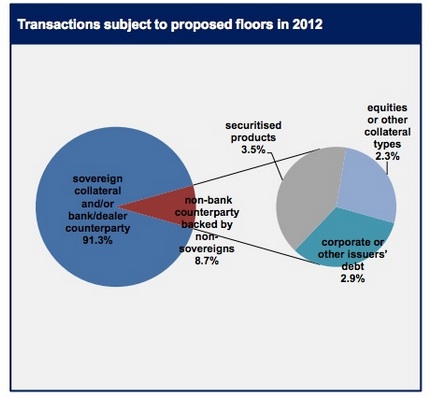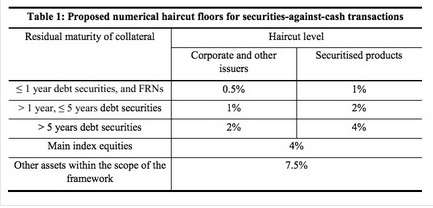The FSB has announced the second phase of their study on haircuts and securities financing. This part will have a narrower focus than their earlier report – its just about haircuts. But interestingly enough, they will talk to a broader cross-section of actors in the market. We have some thoughts.
The minimum haircuts that were espoused in the August 29, 2013 report were, in our opinion, pretty low and narrowly applied. We wrote about this in our posts “Our analysis of the FSB’s securities lending and repo policy framework” (Sept. 2, 2013) and “More on the FSB report on securities lending and repo” (Sept. 4, 2013). Haircuts were lower, by and large, than those seen in tri-party financing trades. For a bank to charge the minimum FSB haircut then finance themselves in tri-party with higher haircuts won’t happen. Banks like to generate liquidity by paying lower haircuts than they charge, not the other way around. We know that these are minimums — but too often competitive pressures make them market norms. The FSB report proposed that only trades between regulated banks and non-regulated counterparties on trades backed by non-sovereign paper would be subject to minimum haircuts. That limits the minimum haircut applicability to 8.7% of market.
 Source: http://www.financialstabilityboard.org/publications/r_130829b.pdf
Source: http://www.financialstabilityboard.org/publications/r_130829b.pdf
Source: http://www.financialstabilityboard.org/publications/r_130829b.pdf
So whom will the FSB be talking to? In the first stage, the FSB obtained data from
“…a group of 17 large financial intermediaries (banks and broker-dealers) from 12 jurisdictions on historical haircut distributions at three specific previous points in time (pre-crisis, post-crisis and current) in order to help calibrate detailed minimum haircut proposals…”
In the new study, the questions will go to
- Regulated financial intermediaries (banks and broker-dealers) are financial intermediaries that are subject to prudential liquidity and capital regulation.
- Agent securities lenders are entities that lend securities on behalf of clients.
- Non-banks are entities that do not fit either of the above categories, and would include asset managers, insurance companies, pension funds and hedge funds, among others, that obtain financing using securities financing transactions.
So banks, sec lenders, and shadow banks.
Will the data from a broader group of participants impact the haircut numbers or widen out the universe of market players that the minimums are imposed on? It is hard to tell. Some have suggested that the haircuts are intentionally low now, but could be easily raised should the need arise. That makes some sense. Having low haircuts that don’t bind the markets when there isn’t stress, then hiking haircuts when necessary, will avoid starting from scratch. But make no mistake that the levels currently proposed are not much more than a sound bite.
A link to the Nov 5, 2013 FSB press release is here.
A link to the Aug 29, 2013 report “Policy Framework for Addressing Shadow Banking Risks in Securities Lending and Repos” is here.
A link to our Sept 2, 2013 post “Our analysis of the FSB’s securities lending and repo policy framework” is here.
A link to our Sept. 4, 2013 report “More on the FSB report on securities lending and repo“ is here.


